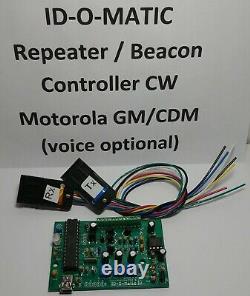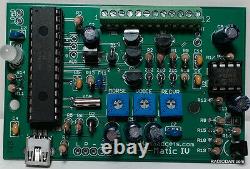
- Home
- Brand
- Material
- Abs (29)
- Abs Plastic (2)
- Aluminum (21)
- Aluminum+ Plastic (7)
- Composite Material (16)
- Glass-fiber Pa (173)
- Kirsite + Plastic (6)
- Metal (12)
- Metal & Plastic (3)
- Metal + Abs (2)
- Metal + Plastic (2)
- Others (3)
- Plastic (42)
- Plastic And Silicone (7)
- Plastic, Metal (2)
- Receptor (2)
- Stainless Steel (2)
- Zinc Alloy + Plastic (3)
- ... (4970)
- To Fit
- Type
- Adapter (26)
- Base Station (23)
- Condenser Microphone (13)
- Controller Set (9)
- Dmx Controller (32)
- Dmx Receiver (19)
- Ham Radio Receiver (11)
- Handheld (13)
- Hdmi Extender (12)
- Image Transmission (14)
- In Ear Monitor (30)
- Intercom (11)
- Lavalier (75)
- Microphone Receiver (55)
- Radio Equipment (29)
- Radio Receiver (9)
- Receiver (122)
- Transmitter (223)
- Transmitter Receiver (18)
- Wireless (15)
- ... (4545)
- Unit Type
- Voltage
Ham Amateur Radio ID-O-Matic IV 4 CW ID Repeater Controller Motorola GM CDM





Not permitted to give it here, so search for "ID-O-MATIC manual" This listing includes. ID-O-MATIC IV 4 built and tested (not programmed). With two 16 pin rear accessory connectors (one for TX radio, one for RX radio) make an instant repeater from any two compatible Motorola radios Any Motorola radios with 16 or 20 pin rear accy connector, programmed for pin-8 COR active low (or high changed in programming). For CDM radios, use center 16 pins. Compatible with GM300, M10, M120, Maxtrac (WITH 16 pin rear connector), CDM750, CDM1250, CDM1550, M1225, CM200, SM50, SM120 and a ny Motorola radios with 16 or 20 pin rear accy connectors, programmed for pin-8 COR active low (or high changed in programming) (Not GTX).
Or any Motorola radios using 16 or 20 pin rear accy connector pins TX radio pins: Pin 2 Mic Hi (audio in) (WHITE to pin 11 IDOM4) Pin 3 PTT active low (GREEN to pin 3 IDOM4) Pin 7 Ground (BLACK to pin 1 or 12 IDOM4). RX radio pins: Pin 7 Ground (BLACK to pin 1 or 12 IDOM4) Pin 8 COR (active low is default for IDOM4) (BLUE to pin 7 IDOM4) Pin 11 discriminator audio out (YELLOW to pin 8 IDOM4) Pin 13 +12 vdc (this is where IDOM4 gets its power) (RED to pin 2 IDOM4). THE MOST popular and economical Repeater / Beacon Controller!
Radiodan has tested EACH and EVERY built unit in the real world for actual use as a repeater controller. A professional in two-way radio for 45 years and a HAM for over 48 years. Every single one professionally built and tested.See our other listings for options like case, audio ID board, programming, Fan relay board, USB programming cable, etc. See our other listings for cables for select. Motorola radios, TYT TH-9000D radios, Kenwood TKR-720 / 820 or TKR-750 / 850 series repeaters. Includes manual link for your download (always the latest version). ID timer/repeater controller with Morse code output.
Keyed CW, audio, and PTT outputs. PTT/audio combination for keying HTs. AMPLIFIED audio mixer for repeater audio and ID. Optional de-emphasis for repeater audio. Super-easy USB port for configuration. Fan control with auto delay (200 ma MAX, fan relay option highly suggested). Optional voice ID for your repeater or fox hunt transmitter. The big question is: How does the ID-O-Matic IV compare to the ID-O-Matic II and III? The big news -- VOICE ID is available as a low-cost option! Morse code IDs are attenuated if the repeater is in use. Voice IDs are replaced by a Morse ID if someone is talking. And, you can set an optional early ID timer to let the ID-O-Matic IV try to ID when the repeater is idle.A real-time clock lets you synchronize beacons to the clock time, and can even be kept accurate with input from a GPS receiver. "Quiet time" lets you silence beacon transmissions during selected hours (like at night). The circuit board is slightly larger than the -III (3" x 1.95" / 7.6cm x 4.95cm), keeps the same connector locations, and the same mounting hole locations. The DB9 connector and serial port used on the ID-O-Matic II are replaced by a USB mini-B connector.
The 10-pin terminal block used on the ID-O-Matic III is replaced with a 12 pin block. There's a second ground for the audio output, and an added an output to indicate when the ID-O-Matic is sending an ID or a beacon. A dedicated output can switch power to a cooling fan, with user-specified turn-off delay. All I/O signal polarity is set via the setup menu; there are no jumpers to set.The board is better optimized for repeater use, with improved volume control. Receiver audio has enough gain to drive virtually any repeater setup due to the on-board low noise audio amplifier.
A protection diode prevents damage to the board if power is connected backwards. Terminal block pins are marked more clearly. The setup menu is vastly improved. As before, no special software is needed -- the device shows up as a regular COM serial port (but needs no tricky serial configuration). The new bootloader software enables field upgradeable firmware.
You can load new firmware using a very simple process, no special hardware or software needed. Installing new features or bug fixes takes about five minutes. There's no need for a separate power supply during setup and testing -- power can be drawn from the computer's USB port. Random beacon timing option - great for fox hunts! Many new or enhanced features - and even more to come!
The ID-O-Matic IV is a multipurpose, microcontroller based device intended primarily for repeaters, but with other uses as well. It can also be used for beacons, fox hunt transmitters, automatic station ID and many other uses. So what are the more interesting features?
There's a programmable delay timer that announces your call sign or any other message, in Morse code at a speed and audio tone you choose. Then there are the CW keying and PTT outputs so you can attach it to a transmitter, transceiver or repeater. The COR/squelch input can be used to make a repeater controller/IDer that works the way you want it.And how about a new USB interface to connect to your shack computer, laptop or terminal for quick and easy configuration? Using the built-in USB interface, connect the ID-O-Matic IV to a PC (Windows, Mac, or Linux) with a free terminal emulation program such as PuTTY or Minicom and you can use the simple menu to configure the ID-O-Matic IV the way you want it. Just type in your ID message.
When the COR input is activated the ID-O-Matic IV will send the message at regular intervals. And now, with the optional add-on voice ID board -- record your own voice ID and use that instead of (or in addition to) Morse code! The COR input is used to control when the ID-O-Matic IV sends your programmed Morse code ID. You can use a squelch, COR, PTT or other signals from your equipment according to your needs. The built-in interface circuit and programmable signal polarity let you use either active-high or active-low input signals.
You can optionally have the ID-O-Matic send a courtesy beep (or up to three Morse code characters) at the end of each transmission, and you can specify a "hang time" to keep PTT active for a brief period after the input stops. If you want the repeater to ID every so often when it's idle, there is a beacon timer and a separate message for that too. You can, for example, have the repeater ID with its call sign while being used, and a longer message every hour or two when it's idle. Or use Morse for the regular ID, and a voice announcement for the beacon.The ID-O-Matic IV has a real-time clock, so you can synchronize the beacon ID to the wall clock if you want. There's a PTT watchdog timer to keep your repeater from being "hung" by stuck mic buttons or long-winded users. And, you can use the ALT MSG input to send a different ID message (and even change the courtesy beep) based on the state of an input signal - useful if, for example, your site switches to backup power, or if a link is active. Regardless of the mode used, the PTT output is active during the CW ID, with a programmable pre- and post-ID delay. Speed is variable from 5 to 40 words per minute, and the audio pitch for the CW ID and the courtesy beep is also programmable via the setup menu.
All outputs are equipped with robust 2N7000 MOSFETs that can handle up to 60V at up to 200 mA to key transmitters or other loads. Improvements have been made to the original ID-O-Matic's Morse audio output. The -IV boasts a smooth, nearly pure sine wave audio signal rather than the raspy square wave found in some ID circuits. The on-board Morse ID is filtered and fed to a passive audio mixer with volume control. An input is provided for external audio from your receiver or other source; this input has a low noise audio amplifier IC with volume control and is mixed with the Morse audio. There is a de-emphasis filter on the external audio input that can be included or left off at build time, depending on your needs. "Future-Proof" : The heart of the ID-O-Matic IV's functionality is the firmware program that controls the processor. The controller can be upgraded with new firmware in minutes, without the need to return it for programming, swap chips or even remove it from the repeater (although a few minutes of down time is required). New features are planned for future release, giving you added capabilities at no added cost. The ID-O-Matic IV 4 from Radiodan is completely professionally built and tested. All you need to supply is an enclosure if desired and a source of DC power (unless GM/CDM cables are ordered, then power is taken from the Motorola receiver radio).We get it out the same or next day depending on when you order. This item is in the category "Consumer Electronics\Radio Communication\Ham, Amateur Radio\Other Ham Radio Equipment".
The seller is "radiodan-w7rf" and is located in this country: US. This item can be shipped to United States, Canada, United Kingdom, Denmark, Romania, Slovakia, Bulgaria, Czech Republic, Finland, Hungary, Latvia, Lithuania, Malta, Estonia, Australia, Greece, Portugal, Cyprus, Slovenia, Japan, Sweden, Korea, South, Indonesia, Taiwan, South Africa, Thailand, Belgium, France, Ireland, Netherlands, Poland, Spain, Italy, Germany, Austria, Bahamas, Israel, Mexico, New Zealand, Philippines, Singapore, Switzerland, Norway, Saudi Arabia, United Arab Emirates, Qatar, Kuwait, Bahrain, Croatia, Republic of, Malaysia, Brazil, Chile, Colombia, Costa Rica, Panama, Trinidad and Tobago, Guatemala, El Salvador, Honduras, Jamaica, Antigua and Barbuda, Aruba, Belize, Dominica, Grenada, Saint Kitts-Nevis, Saint Lucia, Montserrat, Turks and Caicos Islands, Barbados, Bangladesh, Bermuda, Brunei Darussalam, Bolivia, Ecuador, Egypt, French Guiana, Guernsey, Gibraltar, Guadeloupe, Iceland, Jersey, Jordan, Cambodia, Cayman Islands, Liechtenstein, Sri Lanka, Luxembourg, Monaco, Macau, Martinique, Maldives, Nicaragua, Oman, Peru, Pakistan, Paraguay, Reunion, Vietnam, Uruguay.
- Custom Bundle: No
- Compatible Brand: Hamgadgets
- Type: Repeater controller
- MPN: IDOM4
- Non-Domestic Product: No
- Country of Manufacture: United States
- Modified Item: No
- Brand: Hamgadgets

